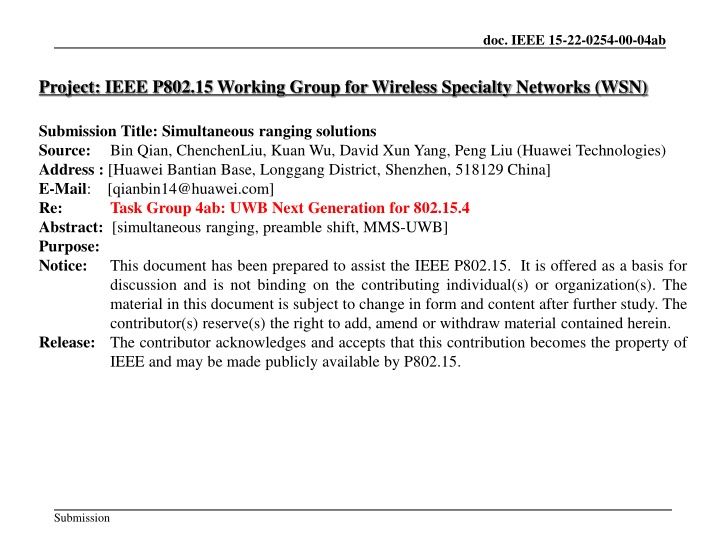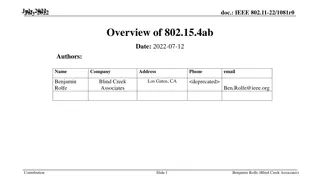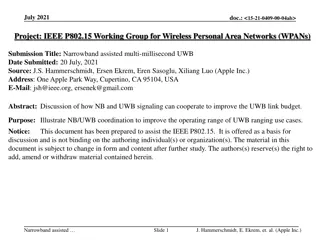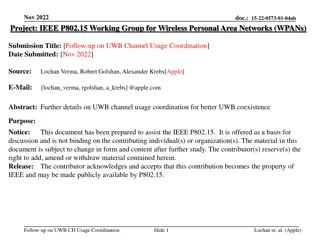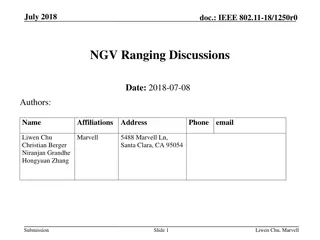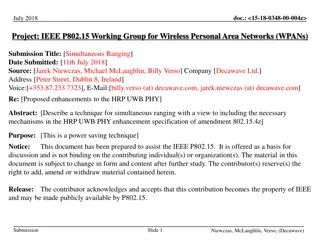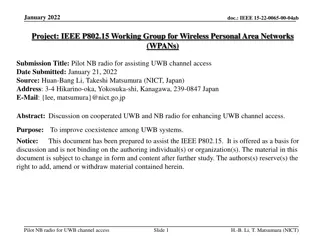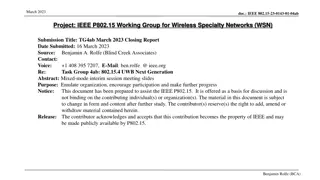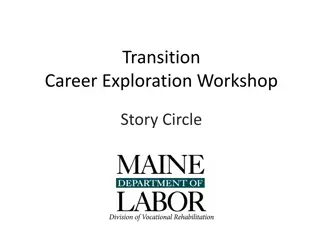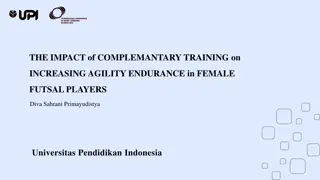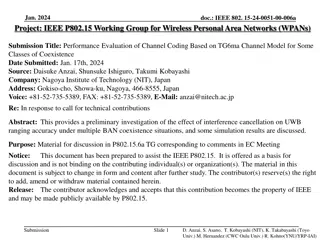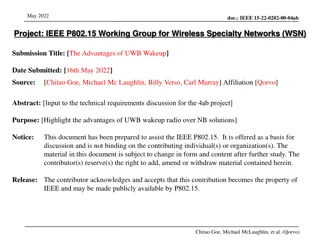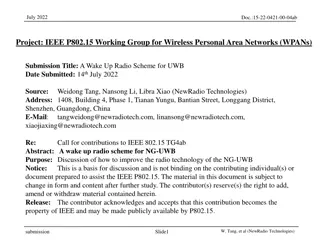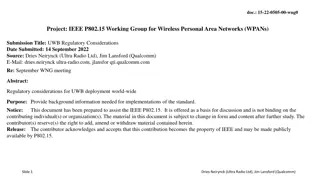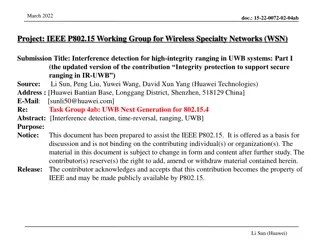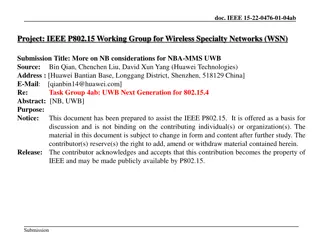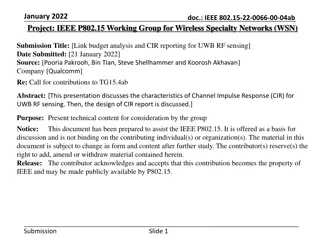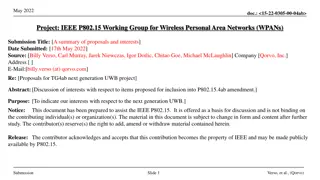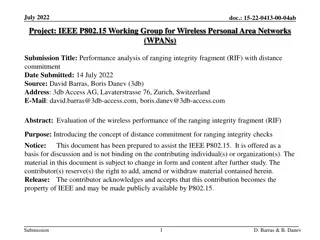Simultaneous Ranging Solutions in UWB Next Generation
This submission explores simultaneous ranging solutions in the context of Ultra-Wideband (UWB) technology for high-throughput data use cases. It discusses interference mitigation techniques, coexistence improvements, and solutions to enable simultaneous ranging, aiming to enhance accuracy, reliability, and power efficiency in wireless networks.
Download Presentation

Please find below an Image/Link to download the presentation.
The content on the website is provided AS IS for your information and personal use only. It may not be sold, licensed, or shared on other websites without obtaining consent from the author.If you encounter any issues during the download, it is possible that the publisher has removed the file from their server.
You are allowed to download the files provided on this website for personal or commercial use, subject to the condition that they are used lawfully. All files are the property of their respective owners.
The content on the website is provided AS IS for your information and personal use only. It may not be sold, licensed, or shared on other websites without obtaining consent from the author.
E N D
Presentation Transcript
doc. IEEE 15-22-0254-00-04ab Project: IEEE P802.15 Working Group for Wireless Specialty Networks (WSN) Submission Title: Simultaneous ranging solutions Source: Bin Qian, ChenchenLiu, Kuan Wu, David Xun Yang, Peng Liu (Huawei Technologies) Address : [Huawei Bantian Base, Longgang District, Shenzhen, 518129 China] E-Mail: [qianbin14@huawei.com] Re: Task Group 4ab: UWB Next Generation for 802.15.4 Abstract: [simultaneous ranging, preamble shift, MMS-UWB] Purpose: Notice: This document has been prepared to assist the IEEE P802.15. It is offered as a basis for discussion and is not binding on the contributing individual(s) or organization(s). The material in this document is subject to change in form and content after further study. The contributor(s) reserve(s) the right to add, amend or withdraw material contained herein. Release: The contributor acknowledges and accepts that this contribution becomes the property of IEEE and may be made publicly available by P802.15. Submission
Slide 2 doc. IEEE 15-22-0254-00-04ab PAR Objective Safeguards so that the high throughput data use cases will not cause significant disruption to low duty-cycle ranging use cases Interference mitigation techniques to support higher density and higher traffic use cases Other coexistence improvement Backward compatibility with enhanced ranging capable devices (ERDEVs) Improved link budget and/or reduced air-time Proposed Solution (how addressed) Proper preamble cyclic shift mitigates the interference among different responders Additional channels and operating frequencies Improvements to accuracy / precision / reliability and interoperability for high-integrity ranging Solutions to enable simultaneous ranging The time of correlation operation is reduced at the receiver to save power by simultaneous ranging Reduced complexity and power consumption Hybrid operation with narrowband signaling to assist UWB Enhanced native discovery and connection setup mechanisms Sensing capabilities to support presence detection and environment mapping Low-power low-latency streaming Higher data-rate streaming allowing at least 50 Mbit/s of throughput Support for peer-to-peer, peer-to-multi-peer, and station-to- infrastructure protocols Infrastructure synchronization mechanisms Submission
May 2022 doc. IEEE 15-22-0254-00-04ab Simultaneous ranging solutions Submission Slide 3 Bin Qian, Chenchen Liu, Huawei
May 2022 Recap - Multiple Transmissions in One Slot doc. IEEE 15-22-0254-00-04ab In [1], the concepts of multiple transmissions in one ranging slot is introduced in the DL-TDOA scenario Multiple devices transmit different Ipatov preambles at the same time Challenge: the receiver is required to perform multiple correlation operations which may increase the complexity Submission Slide 4 Bin Qian, Chenchen Liu, Huawei
May 2022 doc. IEEE 15-22-0254-00-04ab Simultaneous Ranging Time Shift An enhancement to the ranging is the so-called simultaneous ranging [2], which enables multiple devices to respond at almost the same time with overlapping frames. Each responding device has a different delay and applies the same Ipatov preamble sequence such that the receiver only needs to perform the correlation operation once. By time shift, the correlation duration is roughly equal to the Ipatov preamble length instead of the Ipatov preamble length times the number of responders, which reduces the complexity. Note that the Ipatov preamble here is a sequence that can differ from the existing sequences used in 15.4z Submission Slide 5 Bin Qian, Chenchen Liu, Huawei
May 2022 doc. IEEE 15-22-0254-00-04ab Practical Issues of Time Shift Solution An even wider range of applications based on the unique capabilities of UWB are emerging, which may require hundreds or more devices up to 100m distance [3]. The multi-millisecond UWB could be used to improve the link budget, where each millisecond may consist of preamble-only fragments [4]. In order to avoid the ambiguity problem, i.e., the earlier transmitted UWB signals from one responder need to be received earlier by the initiator, the minimum step size of the silence duration ? is at least???? maximum ranging range, ? is the speed of light. Additionally, the multi-path effect should be considered. According to the UWB channel model (CM1 CM9), the PDP (power delay profile) channel length ranges from 79ns to 806ns (the average power is larger than -40dB), and the mean RMS delay ranges from 8.7ns to 79.3ns [5]. Taking the ambiguity problem and multi-path effect into account simultaneously, the minimum step size of the silence duration ? ???? ? ?, where ???? is the +multi-path delay. Submission Slide 6 Bin Qian, Chenchen Liu, Huawei
May 2022 doc. IEEE 15-22-0254-00-04ab Practical Issues of Time Shift Solution In the SS-TWR scheme, the measurement error caused by clock offset between the initiator and the responders is proportional to the reply time of the responders Time shift solution may increase the reply time. For example, let s consider the MMS-UWB case where there are 32 fragments, each lasts about 30us. Assume there are 100 responders and the silence delay step size is 250ns, the largest silence delay would be about 25us The larger reply time results in larger measurement error Submission Slide 7 Bin Qian, Chenchen Liu, Huawei
May 2022 doc. IEEE 15-22-0254-00-04ab Practical Issues of Time Shift Solution Additionally, since there is no priori information about the location of each responder at the controller side, the silence time is assigned to each responder according to a base value (e.g., 250ns) multiplying by a randomly selected number from the set ?,?, ? ? It is possible that the UWB signals from the remote responder are received by the initiator first. The power of above UWB signals are attenuated heavily due to the long distance, in this case, it is difficult to determine the threshold of the power detection and start to perform the correlation operation - Large threshold may lead to the loss of useful UWB signals - Small threshold may increase the correlation duration especially in the high-density device environment Submission Slide 8 Bin Qian, Chenchen Liu, Huawei
May 2022 doc. IEEE 15-22-0254-00-04ab Simultaneous Ranging Preamble Shift Actually, the simultaneous ranging could be also achieved by shifting the preamble sequence instead of staggering the transmission start time In this scheme, each responder generates its own preamble sequence based on an identical base Ipatov sequence by cyclic shifting the above base sequence with proper positions in one direction respectively. The shifted preamble sequences from responders are aligned to start at the same time Submission Slide 9 Bin Qian, Chenchen Liu, Huawei
May 2022 doc. IEEE 15-22-0254-00-04ab Simultaneous Ranging Preamble Shift The shifted preamble sequences introduce offsets between different packets, e.g., ? ?, ? ?,?, ? ? , where ? is the step size of the cyclic shift At the receiver side, the length of the correlation window is just around the length of the preamble sequence even in the high-density device environment, which reduces the complexity and saves power The value of ? depends on two factors Ambiguity problem. Through the cyclic shift, the interval of adjacent two peaks after the - correlation operation between the received UWB signals and the local stored sequence is ? in theory. However, due to the different distances from the transmitter to the receiver, there exists peak drift. The value of ? should be large enough such that the relative order of the peaks corresponding to different transmitters is not changed Multi-path effect. Besides, the peak of the reflected path from one transmitter should be - avoided to appear where the peaks of LOS path from other transmitters Submission Slide 10 Bin Qian, Chenchen Liu, Huawei
May 2022 doc. IEEE 15-22-0254-00-04ab Simultaneous Ranging Preamble Shift Ambiguity problem illustration Case 1: UWB fragment signals from Responder A, B and C are received simultaneously. The interval of peaks is ? exactly. - Case 2: Due to the distance difference, the peak interval between Responder B and C are got smaller, however, the peak corresponding to Responder B still appears earlier. There is no ambiguity problem - Case 3: The extreme situation in case 2, the peak corresponding to Responder C appears earlier than that of Responder B, which incurs the ambiguity problem - Case 3 Case 1 Case 2 Submission Slide 11 Bin Qian, Chenchen Liu, Huawei
May 2022 doc. IEEE 15-22-0254-00-04ab Preamble Shift - Implementation Advantages Advantages All the responders have the same reply time, thus the measurement error in the SS-TWR - scheme would be similar Since the UWB signals are transmitted simultaneously, the signals from the nearest - transmitter are received first. Due to the short distance, the signal strength attenuation is limited. Thus, it is easier to determine the power detection threshold to start to perform correlation operation The preamble shift method could be treated as equivalent as the time shift method. The silence delay step size ? and the preamble cyclic shift step size ? are related as ? = ? ??? . For example, let ? = ???ns, ??? = ???MHz, ? = ?? Submission Slide 12 Bin Qian, Chenchen Liu, Huawei
May 2022 doc. IEEE 15-22-0254-00-04ab Preamble Construction In order to support simultaneous ranging, the long preamble sequence is required especially in the high-density device environment. For example, if the cyclic shift step size ? is assumed to be 64, and there are up to 100 responders, the preamble sequence length is at least 6400. The long Ipatov preamble sequence can be constructed by two short Ipatov sequences Let ? and ? be two Ipatov sequences of respective lengths ?? and ??, which are relatively prime. By repeating the sequence ??? times and the sequence ??? times, and multiplying them element-wise, the resultant product sequence forms an Ipatov sequence - of length ???? Submission Slide 13 Bin Qian, Chenchen Liu, Huawei
May 2022 doc. IEEE 15-22-0254-00-04ab Use Cases One-to-many SS-TWR Many-to-many SS-TWR Submission Slide 14 Bin Qian, Chenchen Liu, Huawei
May 2022 doc. IEEE 15-22-0254-00-04ab Summary In this presentation, some aspects of the simultaneous ranging are introduced: A time shift and a preamble shift based simultaneous ranging - solutions are compared Compared with the time shift solution, the preamble shift solution has - two implementation advantages The reply time of all responders are same It is easier to determine the start of the correlation window The simultaneous ranging solutions could be used in the one-to-many - and many-to-many ranging scenarios Submission Slide 15 Bin Qian, Chenchen Liu, Huawei
May 2022 doc. IEEE 15-22-0254-00-04ab References 1. Mingyu Lee, Taeyoung Ha, Jungyoung Choi, Karthik Srinivasa Gopalan, Aniruddh Rao Kabbinale, Ankur Bansal, Clint Chaplin, Multiple transmissions in a ranging slot, IEEE 802.15-22-0179-00-04ab, March, 2022. 2. Petr Sedlacek, Martin Slanina, and Pavel Masek, An overview of the IEEE 802.15.4z standard and its comparison to the existing UWB standard , 29th International Conference on Radioelektronika, April, 2019. 3. Dieter Coppens, Eli De Poorter, Adnan Shahid, Sam Lemey and Chris Marshall, An overview of ultra-wideband (UWB) standards (IEEE 802.15.4, FiRa, Apple): interoperability aspects and future research directions , arXiv:2202.02190 4. Ersen Ekrem, Ido Bettesh, and Moche Cohen, More on narrowband assisted multi-millisecond UWB , IEEE 802.15-21-0593-01-04ab, Nov, 2021. 5. Carlos Aldana, Qiyue Zou, Preamble codes for data communications in 802.15.4ab , IEEE 802.15-21-0377-02-04ab, Sep, 2021. Submission Slide 16 Bin Qian, Chenchen Liu, Huawei
